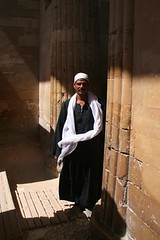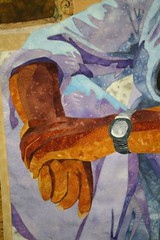Looking for Hashim
Heat wraps around you like hot milk when you step outside - or in my case, when I walk up the stairs to the roof where my studio is. The last two flights are very hot as no air conditioning gets there and there is a huge glass window which belts out heat. It is the sort of heat that I dread entering, then as I go out I think "Really this is not too bad." Then halfway down the block to get a cab it starts to hit and sweat is trickling down my back.
This morning I walked out to join a friend for a 'lady' lunch. There were no cabs for some strange reason outside Seoudi market - there are always cabs here so it was odd - and I walked a couple of blocks to pick one up. I could almost feel my makeup sliding off in a sheet! When I found a cab I was not sure I was better off - climbing into a hot metal box never seems like a good idea in extreme heat and the vinyl seat had been in the sun. Worse - I had a cranky cabbie who grumbled all the way - all of four blocks - to my friend's house.
However - I had fun yesterday.
I had called up one of my friendly drivers to take me out to Saqqara to chase down Hashim. This is the man who is the subject of my latest quilt.
He works at Saqqara, but the last couple of times I have been out there I have missed him, or he is not on that shift. A phone call to a man who is the Inspector of Antiquities revealed only that they had many men working there called Hashim.
We left early in an attempt to beat the heat. As we crossed the Qasr El Nil bridge (which, by the way, was built by the firm who built the Sydney Harbour Bridge one year later) the statues of the lions that guard each pylon were wrapped. I was sorry for the lions - they are marvelous exaggerations of lean leonine form. One of the other statues, and I am embarrassed to admit that I don't know his name, was surrounded by scaffolding. I loved the silhouettes of the men putting it up - such interesting shapes.


We arrived at Saqqara early. It is the site of one of the first pyramids - the Stepped Pyramid. Did you know that Egyptian tombs used to be covered with a mud brick structure called a mastaba which was intended to keep the mummy safe from grave robbers, ready to be used by its owner in the afterlife? Then an early pharaoh - and in the case of Saqqara it was Xoser - decided to put a mastaba of stone over his tomb, then another mastaba on top of that but a bit smaller - then another - and you have pyramids like the Stepped Pyramid and the original section of the pyramid at Meidum.

It is actually more layers than this but this is the romantic view where I cut off the busloads of tourists and the bottom two levels as well.
We brought out the photograph of Hashim and showed it around. The consensus seemed to be that he was not there today - and I didn't need a translation as it was obvious from the head shaking. Within three minutes we had attracted about three men. One was delegated to go and find Hashim's phone number.


He came back with his hand tightly closed. I assumed he had money in it - but he had actually written the number on his palm.
We attracted attention from tourists as five people craned around his hand to try to decipher the bits of phone number that had disappeared into the creases. It must have looked like palm-reading - which of course it was.
A very loud - shouted - phone call was made and I was told that he lived a long way away - more than two hours. I could not see why someone who lived as far away as Alexandria would work at Saqqara. No - two hours was an exaggeration. He would be home from another job in one hour - could we ring then. We were not allowed to bring the man who had made the phone call as they did not speak to each other.
 Directions were given.
Directions were given.At this point a lot of interest was shown in the photographs of Hashim I was showing around. Suddenly they all wanted photos and I was to bring them back to hand out, as I had with Hashim's. I took a string of men, one after another in the gaps between tourists. I was interested in the machinations of one good looking young man who had sidled into another man's photograph, and then asked for one of his own. For each I took a distant view, and a close up. when I took this man's closeup he changed his mind about how he would look, and the white and very dramatic kaffieh around his neck was suddenly a perfectly and tightly wrapped turban.


One, then two


the full view and the closeup
 and with turban!
and with turban!We drove for an hour. One endearing sight was a woman on a donkey nursing a goat as the donkey trip-trapped along the dusty road. I got out of the car to take a photo and after I had taken it she beckoned me to the other side to show me a kid stuck in position as it was being born. For a horrified moment I thought she was taking it to be killed - but it was going to a vet.

We finally met Hashim on a bridge. Have you ever tried to explain to a slightly worried and suspicious Egyptian the idea of a release paper? It is a concept that does not exist in Egypt - in fact in a lot of places. The idea that someone has to give permission for their picture to be shown in public was obviously foreign to Hashim. I heard bits of the earnest conversation going on and he obviously could not understand whey the Australian Ambassador's wife would want him to sign a paper. Worse - I heard the words for secret police - he was really concerned. In the end we or rather, Wael - my driver for the day - wrote it in Arabic.


And - I have my signed release form. Ahmed, our chef, said "I could have saved a lot of work. I can write that I need four bottles of milk and sign it and put a date on top and in America they would never know what it said.
So - we have added a translation below and had that signed by the translator as a true and accurate version.












